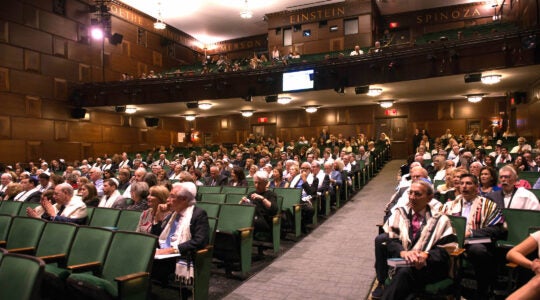In Memphis, 1955, before Johnny Cash was “Johnny Cash,” when he was still crooning forgettable gospel, Sam Phillips, the iconic record producer at Sun Studios, gave young Cash tough advice that turned the singer inside-out: Said Phillips, “If you was hit by a truck, and you was lying out there in that gutter dying, and you had time to sing one song, one song that people would remember before you’re dirt, one song that would let God know how you felt about your time here on earth, one song that would sum you up, you tellin’ me that’s the song you’d sing?”
In these Days of Awe, with God deciding if we’re going to be hit by a truck, if you had time for one prayer before you’re dirt, one prayer to let God know how you felt about your time here on earth, what would you pray about?
By next Yom Kippur, several hundred of us, me as likely as you, will be on the wrong side of the grass. If you’d like your last earthly Rosh HaShanah to be about what the rabbi thinks about politics, that’s your prerogative. Or you can bring a book, as many do, and ignore the sermons entirely. On the Days of Awe, the most personal and internal days on the Jewish calendar, when God decides “who will live and who will die,” you might prefer to think about the Jewish mysteries of incarnation, heavenly soul families, and what happens to the dead after death.
The Days of Awe are about hearing. The dead can hear, says both the Talmud Bavli and Yerushalmi. Each of the holy days correspond to different parts of the body and different senses, and it is a mitzvah to “hear” the wordless heaving cry of the shofar as it performs soul surgery within us.
In Wim Wender’s German-language film, “Wings of Desire,” angels are looking for moments of grace in post-war Berlin, like Abraham in Sodom, or Jonah in Nineveh (the reading on Yom Kippur). One angel in Berlin, imagines the wonders of what it would be like to taste food, to hold a girl’s hand and feel skin-on-skin, or to grip a hot cup of coffee. (Angels, like the dead, have no physical sensation). Similarly, on Yom Kippur, like angels, like the dead, we don’t pick up a cup of coffee, we aren’t physical (no skin-on-skin), we have no earthly consciousness (such as listening to TV news). We exist in the Other World.
Rabbi Lawrence Hoffman, a professor of liturgy and ritual at Hebrew Union College, the Reform seminary, was talking the other day with students there about the ark (the aron) on Kol Nidre night, when Torah scrolls are removed. The empty wooden ark then resembles nothing so much as a casket (also called an aron). A dead man or woman could pretty much fit in it. We spend the day as if dead; our sins by the dozens are recited before the Heavenly Court. At the end of Yom Kippur, comes the shofar’s singular blast, compared by the Talmud to, among other things, the piercing cry of a mother in childbirth. From the aron-turned-casket to birth and reincarnation.
Adam was placed in Eden on Rosh HaShanah and ordered not to eat from the Tree of Knowledge. The Snake said the Tree held the secrets of good and evil, right and wrong. Adam and Eve ate from the Tree and were expelled from Eden on that first Rosh HaShanah. Rosh HaShanah and Yom Kippur were not about humans judging the rest of the world. On Yom Kippur the liturgy states, in a passage adjacent to Kol Nidre, “it is permissible to pray with sinners.” It is a day to show mercy so as to arouse God’s mercy, not to arouse His judgment. It is a day for the Tree of Life, not the Tree of Knowledge.
Imagine Rosh HaShanah or Yom Kippur in the fading days of summer, 1921. If you were around then, perhaps your rabbi’s sermon might be about President Warren Harding’s Teapot Dome scandal, the worst scandal of its time. The Jewish year was 5682. That year thousands of babies were born and assuming they’d live to be 30, they’d encounter the Great Depression, Pearl Harbor, Treblinka and the founding of the State of Israel. An unimaginable number of those babies would suffer from a deadly illness.
In 1921, their parents returned from synagogue, blessed their children, and discussed what the rabbi had to say about … Harding and Teapot Dome? Death was brewing within their children’s generation, with time to sing one song to let God know how you felt about your time here on earth. Harding and Teapot Dome? As Sam Phillips might say, “You tellin’ me that’s the song you’d sing?”
Unlike other holy days, such as Passover or Purim that commemorate historical events, the New Moon of Tishrei, the arrival of the Days of Awe, the most soul-shivering days on the calendar, are barely about the past and almost entirely about the unknown.
Rosh HaShanah is the only holy day that begins on the new moon, and the Days of Awe are mystically linked to the moon, not the sun. Reb Nachman explained that there was the truth of the sun, which is everything we see and know, such as science and history; and the truth of the moon, everything we don’t yet understand or know: Medical discoveries undiscovered, music unwritten, political developments as unimaginable as the State of Israel in 1948, all belonging to the moonlight. Lovers are drawn to moonlight, the holy unknown.
The truth of the sun is that the earth is 5 billion years old. The truth of the moon is that the earth is celebrating birthday 5779 on Rosh HaShanah.
How well did Adam “deep sleep” on that first Rosh HaShanah? The Talmud says that sleep is one-sixtieth of death, but there was no death in Eden. His was the sleep anticipating the love of Eve.
Today, babies cry when put to bed, says Reb Shlomo Carlebach, because they want to hear stories and lullabies, to be held and kissed, “to be assured that their sleep is not the sleep of the dying.”
Children, said Reb Shlomo, “want to sleep on the level of Adam before Eve was created — waiting for something unbelievable to happen.”
With every New Year, the unbelievable will happen. The moonlight knows when.
The New York Jewish Week brings you the stories behind the headlines, keeping you connected to Jewish life in New York. Help sustain the reporting you trust by donating today.




